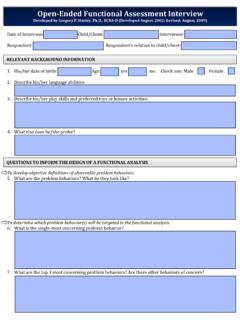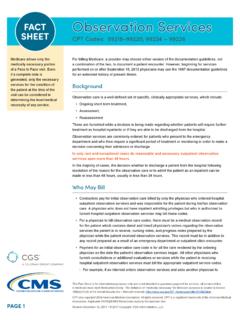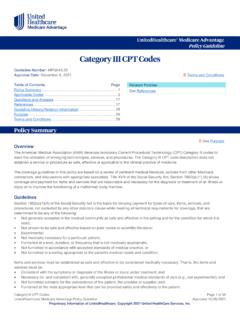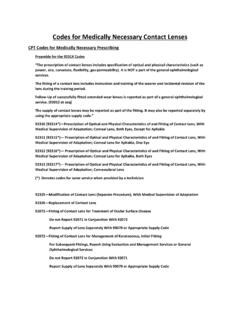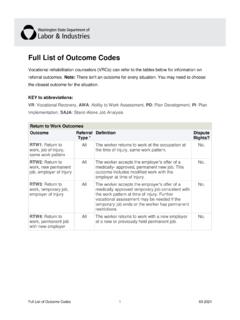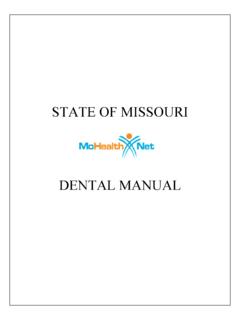Transcription of cpt codes for Applied behavior Analysis
1 2019 CPT ICodes for Applied behavior Analysis :Adoption, Interpretation, and Next Steps145thAnnual ConventionMay 26, 2019 Presented byWayne Fisher, , and Julie KornackTopics Background 2019 CPT I codes Descriptors Payor Adoption of codes Standardization Valuation medically Unlikely Edits Next Steps Q & A2 Background When health insurance began to cover Applied behavior Analysis as a medically necessary treatment, billing codes specifically for Applied behavior Analysis (ABA) did not exist. Payors used a variety of billing codes to pay ABA claims, which caused confusion and impacted claims data collection. In 2012, the Association for behavior Analysis International (ABAI) submitted a code change application to the CPT Editorial of code Development Process42010 ABAI works with American Medical Association to familiarize AMA professional societies with ABA and gain ABAI submits code Change Application to CPT Editorial Multidisciplinary work group submits revised Category III codes take effect July of ABAI forms ABA Services Work Group to develop proposal to modify Category III codes and convert to Category I code Change Application submitted to CPT Editorial ABA Services Work Group presents code Change Application to CPT Editorial CPT Editorial Panel approves 8 modified codes as Category I and 2 modified codes as CPT New CPT I and modified CPT III codes take effect January 1.
2 Category I CPT codes Current Procedural Terminology (CPT) codes are issued, copyrighted, and maintained by the American Medical Association (AMA). CPT I codes are permanent. To qualify for a permanent code , procedure or service must: Be performed by many physicians or other qualified healthcare professionals (QHP) Be performed with frequency consistent with intended clinical use Be consistent with current medical practice Demonstrate clinical efficacy documented in literature that meets rigorous AMA requirements5 Billing code DescriptorsBilling CodeCPT Descriptor 97151 behavior Identification Assessment, administered by QHP, each 15 minutes of QHP s time face-to-face with patient and/or guardian(s)/caregivers(s) administering assessments and discussing findings and recommendations, and non-face-to-face analyzing past data, scoring/interpreting the assessment, and preparing the report/treatment plan97152 behavior Identification Supporting Assessment, administered by one technician under the direction of QHP, face-to-face with the patient, each 15 minutes362 TBehavior Identification Supporting Assessment, each 15 minutes of technicians time face-to-face with patient, requiring four components: QHP on site; assistance of 2+ technicians; patient with destructive behavior .
3 Environment customized to patient behavior97153 Adaptive behavior Treatment by Protocol, administered by technician under the direction of a QHP, face-to-face with one patient, each 15 minutes0373 TAdaptive behavior Treatment with Protocol Modification, each 15 minutes of technicians time face-to-face with patient, requiring four components: QHP on site; assistance of 2+ technicians; patient with destructive behavior ; environment customized to patient behavior97154 Group Adaptive behavior Treatment by Protocol, administered by technician under direction of QHP, face-to-face with 2+ patients, each 15 minutes97155 Adaptive behavior Treatment with Protocol Modification, administered by QHP, which may include simultaneous direction of technician, face-to-face with one patient, each 15 minutes97156 Family Adaptive behavior Treatment Guidance, administered by QHP (with or without patient present), face-to-face with guardian(s)/caregiver(s), each 15 minutes97157 Multiple-Family Group Adaptive behavior Treatment Guidance, administered by QHP (without the patient present)
4 , face-to-face with multiple sets of guardians/caregivers, each 15 minutes97158 Group Adaptive behavior Treatment with Protocol Modification, administered by QHP face-to-face with multiple patients, each 15 minutes6 Adoption of Category I CPT codes HIPAA standards require payors to adopt CPT I codes but do not impose a timeline for adoption. Payors can supplement with HCPCS and other codes . Beginning January 1, 2019, codes were broadly adopted. Some payors have not adopted the CPT I codes . Find resources on the ABAI website: shouldit mean to have Category I codes ? For the 8 Category I codes for adaptive behavior services, there should be: Standardization: More uniform and consistent adherence to the descriptors as approved by the CPT Editorial Panel Recognition of Medical Necessity of ABA: Fewer denials of coverage for ABA services on the grounds that they are experimental, unproven, or not medically necessary 8 Standardization Not So Standard Lack of Standardization: Concurrent billing Assessment codes ( , units, timeframe, 97152) Inconsistent adoption of and inadequate rate for 373T Inconsistent definition of 97155 ( , used for 1:1 ABA by a behavior analyst) Confusion about supervision AMA s Remedy for Lack of Standardization.
5 Amend the code descriptor Add a new billing code9 Billing code Pairs97153971559715497155 Valuation of CPT I CodesThree different options: RUC Survey: Valuation is determined through the AMA Relative Value Update Committee (RUC) process / survey. CMS Rulemaking: Valuation occurs through rulemaking when the Centers for Medicare & Medicaid Services (CMS) assigns values and allows notice and comment of its proposed values. Carrier Pricing:CMS does not set a value, and reimbursement rates are negotiated between providers and funding Pricing CPT codes are carrier priced when a RUC survey is not completed. Rates are negotiated between payors and providers. Providers should know the cost of providing each service before agreeing to rates.
6 Providers should understand pre and post activities associated with each Providers Contribute to Sustainable Rates Calculate the values (rates) for your services. Consider all components of each service ( , overhead, practice expenses, technology, liability insurance, compliance/audit expenses, etc.). Include the services of both technicians and behavior analysts for codes that involve the work of both. Use the resources provided by our Steering Committee and other publicly available information, but take care to do that homework independently of other providers so as to comply with antitrust laws. Understand the cost of pre and post activitiesthat are required but not billable. Negotiate! Always view rates as negotiable, and consider rejecting rates that don t reflect the values you have Valuation of codes Carrier Priced for Now codes are not used by physicians.
7 behavior analysts are not Medicare providers. RUC Survey No specialty society represents behavior analysts. Rate decreases on average by 37% when CMS assigns a value. Payor Trends TRICARE increased rates for 97153 an average of approximately 11%. Payors increasingly recognize concurrent billing of 97153 Unlikely Edits Purpose of MUE is to limit fraud, notto limit medically necessary treatment. Billable units may exceed MUE but may be burdensome to bill. Steering committee has asked CMS/NCCI to increase MUE of some codes . Give us your feedback! Contact you encounter treatment limitations based on Status of MUEsCPT CodeUnits Per DayNotes9715132 for MedicaidOnly Medicare unit of 8 is published. Share Steering Committee letter with payors.
8 *971528 Steering Committee has received requests to increase this Committee has requested this be increased to Committee has requested this be increased to *Available to ABAI members on ABAI website Monitoring developments and updating members/constituents Communicating with payors to encourage adoptionand increase standardization Responding to countless inquiriesfrom members/constituents, payors, and others Presenting at conferences, conventions, and in webinars Working with NCCI to increase MUEs16 Ongoing ABA ServicesSteering Committee ActivitiesProvider Resources Suggestions for provider communications with payors about implementation of the new code set A code conversion table showing relationships between the 2014 Category III CPT codes , other codes , and the 2019 Category I/III codes Supplemental guidance article with clinical examples and FAQs17 Tips for Providers Review your contracts.
9 Know payor policies and requirements for medical necessity and coverage of ABA services, as well as the terms for modification of agreements. Compliance with contract provisions and payor requirements regarding claims documentation is essential, especially in light of recent billing fraud cases and heightened scrutiny of billing for ABA services. Participate in trade organizations. Join a relevant state and/or national group, and use social media to stay connected. Ask questions!18 Questions?19 Email your questions to


